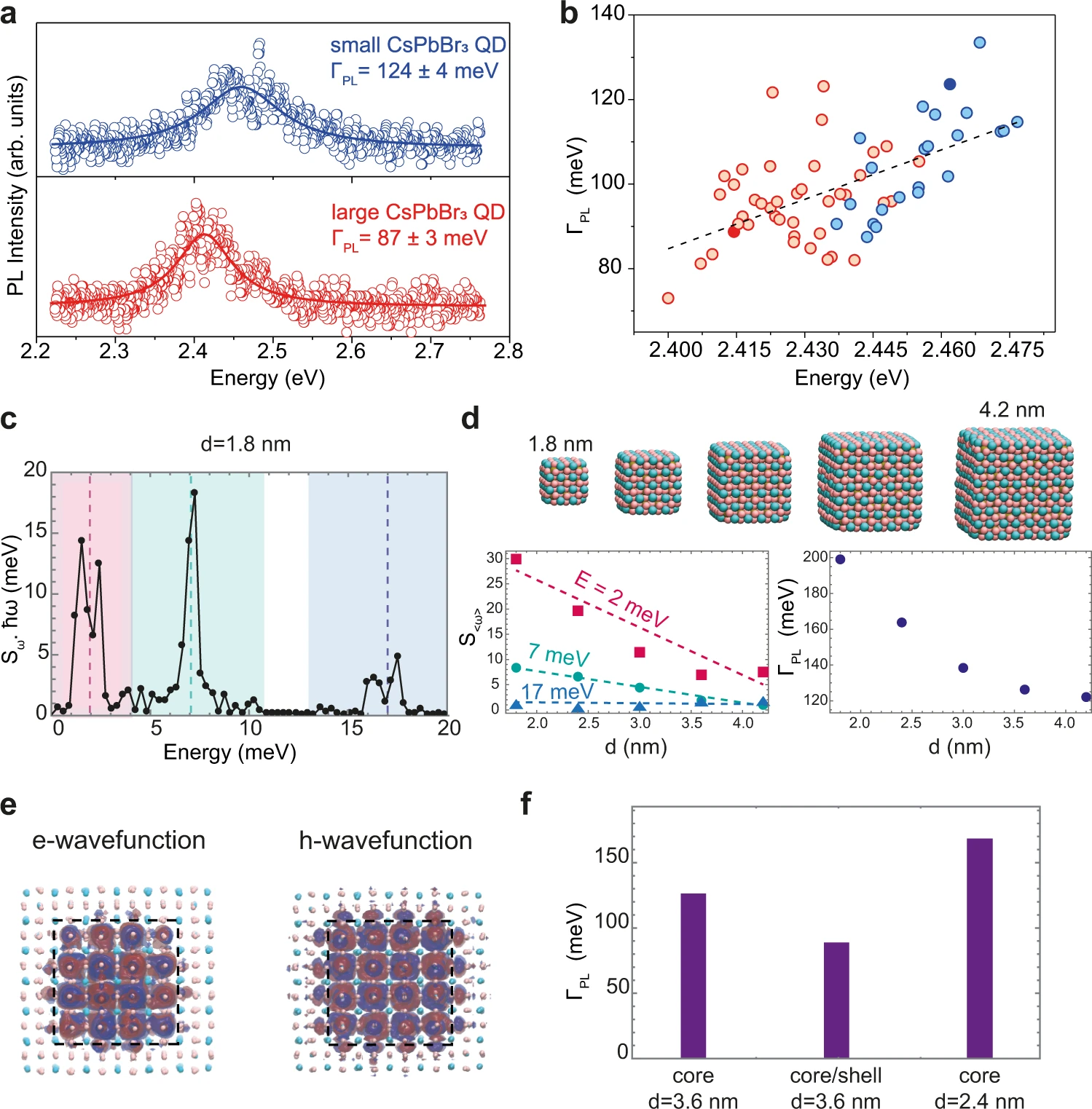Find here the scientific production related to PoLLoC.

Single CsPbX3 Perovskite QDs at Room Temperature
Lead-halide perovskite APbX3 (A=Cs or organic cation; X=Cl, Br, I) quantum dots (QDs) are subject of intense research due to their exceptional properties as both classical 1 and quantum light sources. Here, we report a comprehensive investigation of the room temperature single QD optical properties. The results reveal the origin of the QD homogeneous PL linewidths, and the peculiar size-dependent exciton photoluminescence line broadening and the exciton and multi-excitons recombination dynamics. Experimental results are corroborated by ab-initio molecular dynamics. Such findings guide the further design of robust single photon sources operating at room temperature.

Reaching ultimate perovskite quantum dot optical properties with a new synthetic approach
A new synthetic method for colloidal perovskite nanocrystals has been designed, which offers slow thermodynamic control instead of conventional kinetic growth. The reaction time is increased up to 30 minutes while a wide size range of nanoparticles, some even reaching the strong confinement regime, is obtained with high level control of size and shape. The synthesized quantum dots (QDs) turn out to have a spheroidal shape on average with remarkably well-separated higher absorption peaks. For the first time, this allows for a direct comparison between theory and experimental data related to the transitions beyond the lowest absorption line. Using empirical modelling with second-order many body perturbation theory, we are able to predict the energy positions as well as the oscillator strength of not only the lowest 1s-1s exciton but also of the higher excitonic transitions. The calculated values are in fair agreement with the experimental data. Besides, by taking into consideration the spherical and cuboidal confining potentials, our theory offers an explanation for the well-defined higher transitions in the spheroidal QDs compared to cuboidal ones obtaining from more standard synthetic approaches. The accuracy of the theoretical methods will be also critically discussed.
En savoir plus
Superfluorescence from Binary Perovskite
Lead-halide perovskite APbX3 (A=Cs or organic cation; X=Cl, Br, I) quantum dots (QDs) are subject of intense research due to their exceptional properties as both classical 1 and quantum light sources. Here we present perovskite-type (ABO3) binary nanocrystal superlattices, created via the shape-directed co-assembly of steric-stabilized, highly luminescent cubic CsPbBr 3 nanocrystals (which occupy the B and/or O lattice sites), assembled in combination with spherical Fe 3O4 or NaGdF4 nanocrystals (A sites). These ABO3 superlattices, as well as the binary NaCl and AlB 2 superlattice structures that we demonstrated, exhibit a high degree of orientational ordering of the CsPbBr 3 nanocubes which preserve their high oscillator strength and long exciton coherence time in the assembly. Such superlattices exhibit superfluorescence—a collective emission that results in a burst of photons with ultrafast radiative decay (22 picoseconds) that could be tailored, by structural engineering of the nanoparticle assembly, for use in ultrabright (quantum) light sources. Our work paves the way for further exploration of complex, ordered and functionally useful perovskite mesostructures.

GDR NBODY GENERAL MEETING 2022
Perovskite nanocrystals (NCs) are among the most fashionable names nowadays in the field of colloidal synthesis owing to their superior photoluminescence quantum yield and blinking-free properties, which make them promising materials for both classical and quantum light sources. Their brightness and sub-nanosecond radiative decay originates from the inherent correlation effects. The many-body Coulomb interaction has generally been studied for semiconductor quantum dots. Perovskites, as a consequence of the unique properties of their dielectric functions, possess enhanced Coulomb interaction between the charge carriers. This leads to large binding energies of multi-exciton systems such as trion and biexciton in these NCs or the sizable splitting in the fine structure of single exciton states. Considering each NC as an artificial atom under the envelope function approximation, this problem of correlation effects can be approached at first by using second-order many-body techniques. This offers an elegant and efficient method that provides qualitative results for the trion and biexciton binding energies. In going beyond the second-order description, configuration interaction can be employed to include the correlation energies between the various charge carriers in a more holistic manner.
En savoir plus
The 6th Journées Perovskites Halogénées 2021 (JPH2021)
In the context of rising popularity of perovskites as the potential candidate for many future photovoltaic and lighting applications, the Journées Pérovskites Halogénées 2021 (JPH2021) gathered researchers working on these exciting materials across France. Chemists, physicists and engineers from many experimental and theory groups discussed the diverse and multidisciplinary aspects of the field including synthesis, structural and optical characterization of thin films and nanostructures (0D, 1D, 2D and 3D), etc. These are of crucial importance for the applications in photovoltaics, light detection and LED, thermoelectricity and many more. Three intense sessions were dedicated to the following exciting themes: Synthesis and fundamental properties, Characterization of materials and modelling, Devices and industrial aspects. Interested viewers can find more details from the conference website at https://jph2021.sciencesconf.org. Our current theoretical work under the workpackage WP2 of the European POLLOC project is devoted to the electronic and optical properties of the nanocrystal systems of single exciton and beyond. The contributed talk, which was given during the session “Characterization of materials and modelling” of JPH2021, focuses on the correlation origin of the exciton fine-structure as well as the biexciton/trion emission using many-body perturbation theory as well as the configuration interaction approach. This project was funded by the European Union’s Horizon 2020 program, through a FET Open research and innovation action under the grant agreement No 899141 (PoLLoC).
En savoir plus